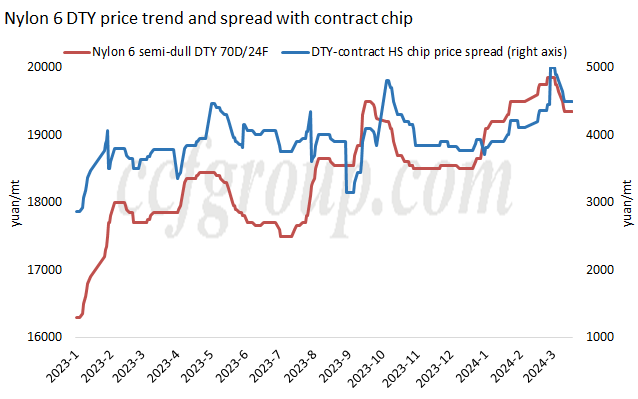Nylon filament new orders weak, but processing fees improves
Entering the second half of March, nylon textile filament market, which was thriving at this time last year (many specifications in 1 month or even longer of pre-sales), is now lukewarm. Although it is now in the traditional peak season for nylon filament, the order taking has fallen short of expectations. New orders taken by filament plants are generally not as active, resulting in increasing equity inventory. Even sun-protection related products, which were popular in 2023, are showing signs of stagnation, with no significant increase in demand. However, despite the lackluster performance in new orders, processing fees for nylon filament have improved overall.
The improvement in processing fees is reflected in several aspects:
1. Pre-holiday presales prices with minimal pressure for post-holiday deliveries
Before the Chinese New Year holiday, from late January to early February, downstream stocked up nylon filament until the end of March or partly until mid to late April, with nylon filament priced based on the basic cost of CPL at 14,000-14,200yuan/mt. The February contract settlement of CPL rose slightly by 105yuan/mt compared to the previous month's price, but the settlement in March is expected to be significantly lower than the pre-holiday stocking price. After the Chinese New Year holiday, the contract raw material cost for filament plants is lower than the presale price before the holiday, meaning that the presale orders before the holiday even have expanded profit margins as raw material costs decrease.
2. Price decrease for new nylon filament orders in Mar is smaller than the decrease in contract raw materials.

During the CPL settlement period (Feb 24-Mar 23) this month, CPL weekly settlement price has dropped from 14,500, to 14,220, 13,500 to 13,450yuan/mt by Mar 18. In the first few weeks, filament plants adjusted their prices based on the same rate as the contract raw materials. In the third week, the contract raw materials dropped significantly by 720yuan/mt to 13,500yuan/mt, but considering the expected monthly settlement, the main filament plants did not follow the raw materials down, instead using 13,800yuan/mt CPL as the price benchmark, resulting in a decrease of only about 400-500yuan/mt. Additionally, the principle of raw materials contract settlement in Mar has been adjusted slightly, so the actual settlement is expected to be lower than the average of the previous four weeks. Therefore, the average price decrease for new orders for filament plants this month will be smaller than the decrease in raw materials, leading to increased profit margins.
3. The advantage of pre-holiday raw material cost is not significant, while there is generally no loss.
Before the Chinese New Year holiday, filament plants also stocked up in moderate amounts of feedstock. Using medium-high-grade semi-dull HS chip as an example, the spot price was between 14,700-15,200yuan/mt. Some filament plants, although the operating rate decreased during the holiday period, still executed the contract in full volume, with the price of the contract semi-dull chip around 15,200-15,400yuan/mt. The pre-sale pricing for filament plants is generally based on a price range of 15,100-15,400yuan/mt for HS chip. Although the advantage of pre-holiday raw material prices is not significant, there is generally no loss. Additionally, in March, some filament plants have also stocked up at lower prices between 14,500-14,600yuan/mt, with some large orders even lower, effectively lowering the overall raw material cost. Therefore, from a cost perspective, there is also an expansion of profit margins for filament plants.
In summary, since the Chinese New Year holiday, both delivery of previous orders and conclusions of new orders for nylon filament have shown improved profit margins to varying degrees. It's only that the orders from downstream weaving and knitting factories are below expectations, and the substantial drop in raw material prices during the peak season has also increased the wait-and-see attitude of downstream mills, resulting in no significant surge in new orders for nylon filament. As the weather warms up, demand for some seasonal products will gradually increase. As time passes, the early period of stocking by fabric factories will also be depleted, so it is expected that downstream demand for nylon filament still has room for growth.
- Top keywords
- Cotton Price
- Cotton Futures Price
- Cotton Futures
- CZCE
- PTA Futures Price
- Chemical Fiber
- Polyester Prices
- Wool price
- PTA Futures
- Shengze Silk
- China
- Yarn Price
- price
- China Textile City
- Fibre Price
- Benzene Price
- Cotton
- Index
- Cotton Index
- PTA
- fabric price
- NYMEX
- Top 10
- textile industry
- Spot Cotton
- Cotton Yarn
- Polyester Price
- Futures
- PTA Price
- cotton yarn price

